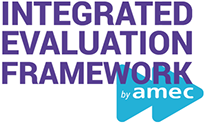INTRODUCTION TO THE AMEC INTEGRATED EVALUATION FRAMEWORK
WHERE DID IT COME FROM AND WHY IS IT IMPORTANT?
Zoals toonaangevende communicatieprofessionals als Fraser Likely en wetenschappers als Emeritus Professor Tom Watson (Likely & Watson, 2013) vaststellen, is onderzoek en evaluatie al bijna een halve eeuw een probleem voor de communicatiewereld. Er is ontegenzeggelijk veel goed werk verricht de laatste jaren en de nodige vooruitgang geboekt, zoals de Barcelona Declaration of Measurement Principles (AMEC, 2015). Desondanks worden beroepsbeoefenaars nog steeds geconfronteerd met een uiteenlopende en vaak verwarrende reeks aan modellen, methoden en metriek. Standaarden ontbreken, waardoor in de praktijk vaak evaluaties achterwege blijven of op twijfelachtige basis worden uitgevoerd.
Een aantal organisaties heeft de noodzaak erkend om standaarden te ontwikkelen en beroepsbeoefenaars te helpen bij de uitvoering.
The AMEC Integrated Evaluation Framework is daarbij een belangrijke ontwikkeling. waarbij AMEC samenwerkt AMEC werkt samen met zowel andere brancheorganisaties, als beroepsbeoefenaars en wetenschappers op het gebied van evaluatie en sociale wetenschappen.
Een belangrijke doorbraak is dat AMEC nu ook heeft gekeken naar evaluatiemodellen in andere bedrijfstakken en wetenschappelijke disciplines. Denk aan performance management, bestuurskunde, organisatiekunde, sociale wetenschappen, psychologie en marketing. Om programma’s op het gebied van (gedrags)verandering te evalueren wordt in deze disciplines veel gebruik gemaakt van het Programma Logica model waarbij aannames, ingezette middelen en resultaten overzichtelijk in een schema worden gezet om de effectiviteit te kunnen beoordelen. Twee voorbeelden:
Het model van The Kellogg Foundation (Kellogg Foundation, 1998/2004), zie http://www.epa.gov/evaluat
The AMEC Integrated Evaluation Framework is built on these widely-used logic models, underpinned by a solid foundation of theory and extensive testing in practice, adapted to strategic public communication.
The AMEC Integrated Evaluation Framework is ontwikkeld op basis van deze modellen, onderbouwd door theorie en uitgebreide testen in de praktijk, toegespitst op Communicatie. Daarbij is ook gebruik gemaakt van bekende (massa)communicatietheorieën en modellen, zoals de fasen in informatieverwerking die W. J. McGuire (1985, 2001) onderscheidt in The Handbook of Social Psychology, en de communication-persuasion matrix. Het AIDA-model (attention, interest, desire, action) uit de advertentiewereld is hiervan afgeleid, alhoewel McGuire meer stappen onderscheidt (McGuire, 2001).
Met het Integrated Evaluation Framework zorgt AMEC ervoor dat de kennis en best practices gebruikt worden om meer consistentie te krijgen in evaluatie van communicatie, wat kan leiden tot standaarden en meer validiteit. De taxonomie, modellen, hulpmiddelen en bronnen sluiten ook goed aan bij planning en programmamanagement modellen in public relations en corporate communicatie, zoals het Research Action Communication Evaluation (RACE) model (Marston, 1981); het Research Objectives Program/plan Evaluation (ROPE) model (Hendrix, 1995); het uitgebreide Research Adaptation Implementation Strategy Evaluation) model (Kendall, 1997; en Sheila Crifasi’s (2000) ROSIE model, met een iets andere volgorde van fases, namelijk: research, objectives, strategies, implementation, evaluation.
Jim Macnamara
Professor of Public Communications,
University of Technology, Sydney
REFERENCES
AMEC (Association for Measurement and Evaluation of Communication. (2015). Barcelona Principles 2.0. Available at http://amecorg.com/barcelona-principles-2-0-infographic
Crifasi, S. (2000). Everything’s coming up rosie. Public Relations Tactics, 7(9), September, Public Relations Society of America.
Hendrix, J. (1995). Public relations cases (3rd ed.). Belmont, CA: Wadsworth.
Kellogg Foundation. (1998/2004). Logic model development guide. Battle Creek, MI: Author. Retrieved from http://www.epa.gov/evaluate/pdf/eval-guides/logic-model-development-guide.pdf
Kendall, R. (1997). Public relations campaign strategies: Planning for implementation (2nd ed.). New York, NY: Addison-Wesley.
Likely, F., & Watson, T. (2013). Measuring the edifice: Public relations measurement and evaluation practice over the course of 40 years. In J. Sriramesh, A. Zerfass, & J. Kim (Eds.), Public relations and communication management: Current trends and emerging topics (pp. 143–162). New York, NY: Routledge.
Marston, J. (1981). Modern public relations. New York, NY: McGraw-Hill.
McGuire, W. (1985). Attitudes and attitude change. In G. Lindzey & E. Aronson (Eds.), Handbook of social psychology, Vol. 2 (3rd ed., pp. 233–346). New York, NY: Random House.
McGuire, W. (2001). Input and output variables currently promising for constructing persuasive communications. In R. Rice & C. Atkin (Eds.), Public communication campaigns (3rd ed., pp. 22–48). Thousand Oaks, CA: Sage.
Taylor-Power, E., & Henert, E. (2008). Developing a logic model: Teaching and training guide. Retrieved from http://www.uwex.edu/ces/pdande/evaluation/pdf/lmguidecomplete.pdf

